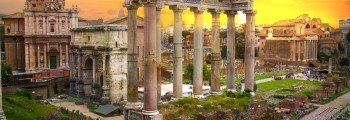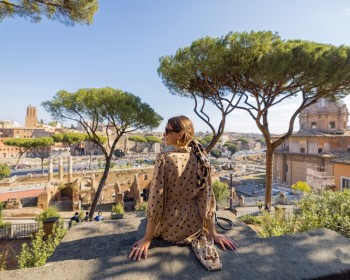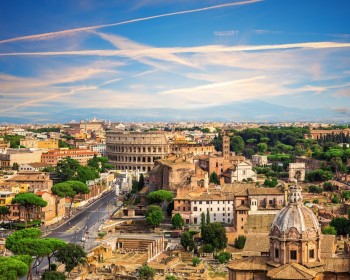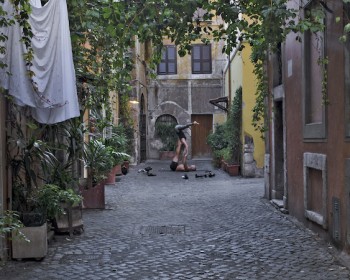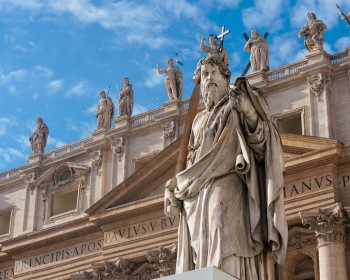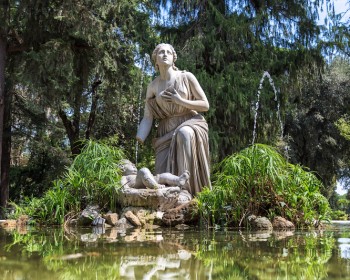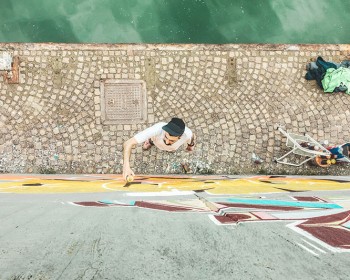Brindisi was one of the most important harbours in Ancient Italy; it was from here that Rome’s trade routes reached out across to Greece and the Orient. It was considered by the Roman “Regina Viarum” (literally translated Queen of the Streets), because it is universally recognized as one of the major building and engineering projects in the Ancient world. Its construction had a huge impact in many areas of society: economic, military and cultural.
In 312 B.C. the Emperor Appio Claudio Cieco decided to restore the old street that connected Rome to Colli Albani. The itinerary was extended to Benevento and Taranto, after Brindisi.
The street was later renovated and extended by others emperors such as Augusto, Vespasiano, Traiano, who created the Appia Traiana, that went to Benevento and Brindisi through “Apulia,” today known as the region of Puglia, crossing cities like Canusum (Canosa) and Barium (Bari). The original ancient Appian way started from Porta Capena, near Caracalla Baths, and linked Rome to Capua (Santa Maria Capua Vetere) crossing Aricia (Ariccia) Forum Appli, Anxur (Terracina) Fundi (Fondi,) Formiae (Formia,) Minturnae (Minturno) and Sinuessa (Mondragone), and also from Capua to Vico Novaensis (Santa Maria a Vico) Caudium (Montesarchio) Apollosa and Monte Corvo to arrive in Taranto through Venusa (Venosa) Silvium (actual Gravina di Puglia), and East to Rudiae (Grottaglie), after Uria (Oria) and Brundisium (Brindisi).
This street is so famous that it even has a whole day dedicated to it. The 14th May is known as Appia day, and you have the possibility to rediscover this old street in many ways: for example walking or by bicycle. A big organizing committee prepares different activities like trekking, cycling tours, archaeological visits, concerts and stalls, that start from Rome and head out to Genzano, Latina, Caserta, Terracina and Taranto, to just mention a few. Along the part of the road inside the city, from ex Cartiera Latina to Cecilia Metella Mausoleum, some of te monuments offered extraordinary openings, there were performances by travelling theatres, a photographical exhibition of Antonio Cederna’s Archive (I’ll speak about him and his importance later in the artcle) documents and another initiative named “Instameet- Raccontando l’Appia”.
On this day we also had the opportunity to get to know the agricoltural biodiversity of the regions surrounding the Appia Way, with products on sale with their origins in Parco del Sannio Beneventano, such as bread from Puglia or a particular type of wheat named “Senatore Cappelli.” One could also fine Slow Food producers who brought distinctive products as a witness of the excellence of the agricoltural vocation of Agro Romano, responsible for the the first farm district of Rome and the surrounding area. As part of this initiative the GRAB (Grande Raccordo Anulare della Bici ) was established, a green pedestrian and cycle route that begins in Piazza Venezia and covers all the ancient Appian Way. On 14th May it has also become tradition to walk a trail from Rome to Santa Maria Capua Vetere, named “Appia Trail.”
Before I speak about the stunning monuments inside the park of Ancient Appia, known as the: Parco degli Acquedotti, a regional suburban park extending across 240 hectares, between Appia and Tuscolana roads, that cross Lemona street, Capannelle street, and Quadraro street.
In this area it is possible find artifacts of different ages: Roman and primarily Reinassance. Here in the Roman age were built eleven water mains and one in Renaissance, Anio Virtus, Acqua Marcia, Tepula, Iulia and Felice, dell’Acqua Claudia, Anius Novus. It is lined with handsome monuments:
- Villa delle Vignacce: this is a suburban house in this area, built by Quinto Servillo Pudente (between II° and VI° century, in the Adrian age.) He was a very rich producer of bricks, who inscribed his name in every brick and every pipe (in latin named Fistulae). Ruins from this house are part of a big thermal complex and two flat tanks, filled from the nearby water main of Acqua Marcia.
- Casale di Roma Vecchia: is named after the town and the nearby “Villa dei Sette Bassi.” The Casale was in a strategic position between the water mains Acqua Claudia and Marcia.
- Fosso dell'Acqua Mariana: named “Marrana” from the Middle Ages, is an open sky pit, realized by Callisto II in 1122 to transport water to Rome from water mains in Tepula and Iulia. The term Marrana indicates every hole that you might see in the city.
- Via del Quadraro: arches from the water main named Claudio that arrive at a maximum altitude of 27-28 metres. Recent discoveries have found sepulchral monuments, and a little mausoleum, made of basalt from via Latina, and a hotel with a thermal system.
- Tomba dei Cento Scalini: named for the steps that descend to the sepulchral room, full of marble sarcophagi, with a particular cover, tunnels inside the tomb, probably used such as cathacombs.
Additionally, in 1784, a new street was constructed that was named Appia Nuova, opened by Gregorio XIII° and extended to via Asinaria, this began at the namesake door of San Giovanni’s gate.
The person that first proposed the institution of a protected area was Antonio Cederna, archeaologist, art critic, writer (titles include“I vandali in casa”, “ Mirabilia Urbis”, “ La distruzione della natura in Italia”) he said that ‘The fight for the safeguarding of our historical and natural values in our nation, is at the same time, the fight to affirm our citizens dignity, a conflict for the advance and the civic consciousness versus the enduring incitement of less privileged almighty.’
Finally, after years of lobbying and campaigning for sensibilization on the matter, in 1988, the “Parco Regionale dell’Appia Antica” was established which still exists today. Inside this magnificient regional park you might see the extraordinary “Villa dei Quintili”, situated between the V° mile on the Ancient Appian Way and the 7th km of Appia Nuova, in 2013, along with the museum of Caracalla Baths, and the tomb of Cecilia Metella, the 22nd most visited national site. Built in the first half of II° century, in Adrian age by Sesto Quintilio Condiano and Sesto Quintilio Valerio Massimo (the names were found in the plumbing structure, next to the tombs of Oriazi and Curiazi, and until 1700 was property of religious heritage. In fact Pope Clemente XIII° himself ordered a dig to be lead.
When it became a property of the Torlionia, Alessandro decided to undergo a new research campaign from 1850 to 1856. In the ’90s many statues of Apollo Citaredo and Artemide were uncovered and are now visible in Museo Nazionale Romano inside Palazzo Massimo, near Termini train station, along with other famous staues such as Discobolo Lancellotti and Augusto Ponefice Massimo.
Why not take advantage and visit these fascinating statues? Or organize a bike ride, walking tour or golf cart tour along Appian Way and its surroundings!

